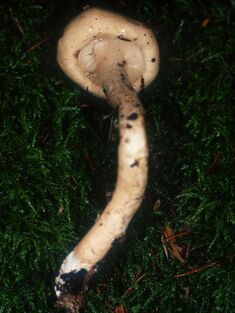Biology:Limacella illinita
| Limacella illinita | |
|---|---|

| |
| L. illinita at Big Basin State Park, California . | |
| Scientific classification | |
| Kingdom: | |
| Division: | |
| Class: | Homobasidiomycetae
|
| Subclass: | Hymenomycetes
|
| Order: | |
| Family: | |
| Genus: | |
| Species: | L. illinita
|
| Binomial name | |
| Limacella illinita (Fries) Earle (1933)[1]
| |
| Limacella illinita | |
|---|---|
| Mycological characteristics | |
| gills on hymenium | |
| cap is conical or convex | |
| hymenium is free | |
| stipe has a ring | |
| spore print is cream to white | |
| ecology is mycorrhizal | |
| edibility: inedible or unknown | |
Limacella illinita, commonly known as the white limacella,[2] or overflowing slimy stem, is a mushroom in the genus Limacella, in the family Amanitaceae.
Description
- Cap : It has approximately 2–7 cm long radius. It is round becoming convex then wide or with a broad umbo, the margin hanging with slimy veil remnants. It is white or cream in color. It feels smooth and sticky or slimy.[3][4]
- Gills : They are free, non-waxy, close, broad and white in color.[3][4]
- Stem / Stipe : The 5–10 cm long stem tapers a bit towards the top. It is fleshy, soft and has a ring. White in color, it is also sticky and slimy.[3][4]
- Spores : Spores are globose to broadly ellipsoid and smooth.[3][4]
- Microscopic features : The spores measure 4.5–6.5 x 4–6 µm.[3][4]
- Flesh : Flesh is slimy and sticky.[3][4]
- Fruiting : These mushrooms flower in between August or July and October or November.[3][4]
Distribution and habitat
L. illinita is widely distributed in North America and often found in Europe. These can habitat singly, scattered, or in groups in woods, swamps, fields, lawns, roadsides and sand dunes.
Bioactive compounds
A study in 2007 discovered four new bioactive compounds from basidiomycetes, isolated from fermentations of L. illinita: Illinitone A that exhibited weak phytotoxic and moderate nematicidal activities against Caenorhabditis elegans, Illinitone B that was moderately cytotoxic, Limacellone that exhibited weak cytotoxic and phytotoxic activities and muurolane sesquiterpene 4a that was found to be inactive in the assays performed there.[5]
References
- ↑ "Limacella illinita". Amanitaceae.org. http://www.amanitaceae.org/?Limacella+illinita.
- ↑ Arora, David (1986). Mushrooms demystified: a comprehensive guide to the fleshy fungi (Second ed.). Berkeley: Ten Speed Press. ISBN 978-0-89815-169-5.
- ↑ 3.0 3.1 3.2 3.3 3.4 3.5 3.6 "Limacella illinita". Rogers Mushrooms. http://www.rogersmushrooms.com/gallery/DisplayBlock~bid~6342.asp.
- ↑ 4.0 4.1 4.2 4.3 4.4 4.5 4.6 Bessette, Alan; Arleen Rainis Bessette; David William Fischer (1997). "Gilled Mushrooms". Mushrooms of northeastern North America. New York City , United States: Syracuse University Press. p. 194. ISBN 0-8156-2707-6. https://books.google.com/books?id=T2uU12XcRD4C&q=Limacella+illinita&pg=PA194.
- ↑ Gruhn, Nina; Sylvia Schoettler; Olov Sterner; Timm Anke (2007). "Biologically active metabolites from the basidiomycete Limacella illinita (Fr.) Murr.". Zeitschrift für Naturforschung C (Germany: Department of Biotechnology, University of Kaiserslautern.) 62 (11–12): 808–812. doi:10.1515/znc-2007-11-1206. ISSN 0939-5075. PMID 18274282.
Wikidata ☰ Q3915457 entry
 |


